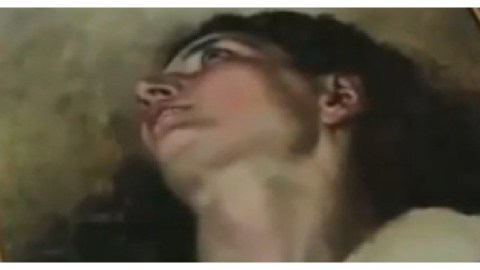Is This the Missing Half of the Most Controversial Painting Ever?

If any painting could be labeled “not safe for work,” it’s Gustave Courbet’s 1866 L’Origine du monde (in English, The Origin of the World; and, once again, NSFW). Banned even from Facebook, proving that prudery’s alive and well in the 21st century, Courbet’s graphically realistic painting of a woman’s nude torso went unseen by the public until 1988 and didn’t enter a museum collection until the Musée d’Orsay accepted it 7 years later. An article in Paris Match (available only in French) reports that a painting has been found that is the “lost” upper half of the painting (shown above), which shows the face of the model of the infamous work. Courbet experts argue over whether or not this really is part of the original L’Origine, but if it is, what does that discovery mean for that painting and for how we see (or don’t get to see) what has become the most controversial painting ever?
Like all good tales, this one begins in the most surprising of places—a simple used furniture store. Looking for bargains, an art buff (who prefers to remain anonymous) stumbled across the painting and on a hunch purchased it after haggling the owner’s price down to just a little under $1,900 USD. The new owner then consulted Courbet authority and author of Courbet’s catalogue raisonnéJean Jacque Fernier, who told Paris Match that“The Origin Of The World finally has a face.” Citing stylistic similarities, results of chemical and spectographic tests, and the way that the frames and weave of the canvases match up, Fernier stakes his reputation on the connection between the pieces, going so far as to include the portrait in the updated catalogue raisonné, the academic stamp of approval. That stamp of approval naturally comes with a bump in value, which some estimate at $55 million USD.
Other scholars, including those connected with the Musée d’Orsay (the “bottom” half’s home), reject the idea that this is the lost face of L’Origine. Fernier offers as another piece of evidence a contemporary sketch apparently showing the full-length work before the separating surgery was performed, but critics counter that the sketch, which may not be by Courbet, either shows a rejected idea or another work (perhaps lost) entirely.
This is just the latest, but not the strangest chapter in the history of The Origin of the World. The standard mythology around the painting begins with an alleged commission by an Ottoman empire diplomat named Khalil Bey. Khalil Bey already owned Ingres‘ The Turkish Bath and another Courbet titled The Sleepers, but wanted to add to his private collection of erotic paintings. When his finances turned sour, the diplomat sold his collection, including L’Origine, which then passed through several, presumably male hands. In 1889, Edmond de Goncourt found the painting hidden behind a wooden panel in an antique shop. The painting resurfaced again in 1910 in Budapest, where later Russian troops briefly seized it in the chaos of World War II, before the owner paid the requested ransom. The owner then fled to Paris with the painting, where it was sold at auction for 1.5 million francs in 1955 by Jacques Lacan. The painting remained out of the public eye until a Brooklyn Museum show about Courbet in 1988. In 1995, 14 years after Lacan’s death, as part of the estate’s inheritance tax settlement, the painting entered the French government collection of the Musée d’Orsay, where it remains today.
The story of the alleged “face” may never be known, but a good guess can be made about the model of the face (and, presumably, the bottom half). Joanna Hiffernan, a red-headed Irish beauty who became model, muse, and lover not only to Courbet, but also to James Abbott McNeill Whistler. A vivacious, fiercely intelligent woman, Jo painted as well as modeled, but she is known primarily today for her modeling (clothed) for Whistler’s for Symphony in White, No. I: The White Girl and Symphony in White, No. 2: The Little White Girl. Hiffernan’s also identified as one of the sleepers in Courbet’s The Sleepers, which Khalil Bey also owned, so perhaps diplomat’s commission came with a special request for a sequel, this time in extreme (and extremely erotic) close-up.
Hiffernan’s long been suspected as the model for L’Origine, but this top half, if truly part of the painting, could end all speculation. Assuming that L’Origine’s finally been reassembled, the question must be raised as to who and why dismembered it in the first place? If Courbet did it, was he trying to protect Hiffernan in some way, realizing the first full-length painting was a mistake? If so, why not destroy the facial portrait entirely? Perhaps Courbet couldn’t bear to destroy his work and his lover’s image. Maybe he never suspected that the two halves would or could ever be reunited. I doubt Khalil Bey performed the surgery considering his already proven appreciation for Jo’s full-length figure in The Sleepers.
The question foremost in my mind is how this reunion changes the painting and how we perceive it. Presented purely as female genitalia with the title The Origin of the World, the non-erotic message is clear: here’s where all life springs from, which is a beautiful, rather than a dirty place. Presented without the influence of the title, however, does L’Origine become the pornographic, dehumanized, almost misogynist image hidden away from the public eye in one way or another for nearly a century and a half? Is the “other half” of the painting actually the title and not its face?
But what does the face finally tell us. By all accounts, Hiffernan was a bright, bold, sexually liberal woman for her time. In Whistler’s Symphony in White, No. I: The White Girl, Jo meets the viewer’s gaze with her own, albeit in a symphonically long white dress. What does it mean that the model turns away? Can’t she meet our gaze directly, like the model in Édouard Manet’s Olympia, painted 3 years before Courbet’s L’Origine du monde, the most controversial painting in the world prior to L’Origine du monde, and another resident of the Musée d’Orsay? Granted, the model in Olympia covers her genitalia with her left hand, but she’s otherwise on full erotic display, which is made even more brash by her unwavering gaze at the viewer.
But shouldn’t Hiffernan be looking out, too? By turning away, is Hiffernan dramatizing her sexual abandon? Is this a moment of sexual rapture, an acknowledgment of female sexual pleasure on an epically realistic scale rarely scene before or since? Or is this a moment not of abandonment to the throes of passion but of abandonment to the male gaze and the “virtual” male touch? Does reconnecting the face to the torso of L’Origine du monde reconnect and reenact a kind of rape scene Courbet couldn’t allow out of his hands? Could Hiffernan have seen the complete work and vetoed it on the grounds of that possible interpretation, which she may have seen more quickly than Courbet? Could she have tolerated a faceless visual violation by a high-paying private collector and not the more intimate idea of her face, and maybe her soul, being part of the exchange?
Even if we are able to recreate the L’Origine du monde, we’ll never be able to recreate the thought processes and negotiations that went on during its origin and reimagining. If this really is the face of The Origin of the World, then the most controversial painting in the world may have become even more controversial by resurrecting issues of sexuality as old as the origin of the world itself.





